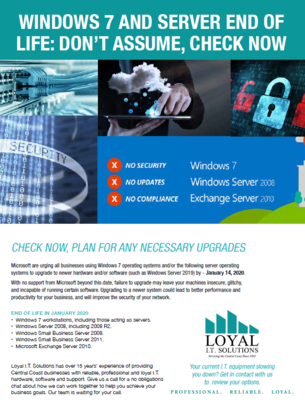Windows 10: Better for Business

With more than 800 million users, the Windows 10 operating system has had a faster adoption rate than any other version of Windows. It has also recently been crowned as the most popular operating system for desktops, running on 44% of all computers across the globe.
Windows 10 has kept the familiarity of a classic Windows interface, while achieving major improvements in terms of security, efficiency, and performance. Market research company Forrester has put these claims to the test and discovered the following results:
- Increased Productivity: Managing your desktop and open programs takes 15-20% less time with Windows 10, helping you work more productively. Features such as Task View let you see all open programs at a glance, so that you can quickly locate the different windows that are required for your tasks.
- Security Improvements: Windows 10 boasts a 33% reduction rate in security issues and their resolution time. With a firewall and basic antimalware protection built directly into the operating system, Windows 10 delivers additional security features that can assist in keeping your network safe.
- Reduced Costs: The ease-of-use of Windows 10 could create up to 15% in cost savings for your business. Windows 10 comes with many self-service help functions as well as built-in troubleshooters for network connections and printers, helping you to quickly resolve common technical issues. Windows 10 is also easier for your I.T. provider to manage, taking less time to install, troubleshoot, and support.
- Better Performance: Windows 10 devices can have up to a 75% reduction in boot time compared to a Windows 7 machine, making it much quicker for you to get started with your day.
- No More Upgrades: Microsoft have announced that Windows 10 will be the last major version of Windows. Rather than releasing a new operating system every few years and requiring all users to upgrade, Microsoft will instead release improvements and new features to Windows 10 on a regular basis through small incremental updates. This means reduced I.T. spending for your business, as machines only have to be replaced due to hardware degradation instead of being replaced to keep up with major software changes.
With Windows 7 becoming end-of-life in January 2020, Microsoft recommend that any Windows 7 devices be replaced with Windows 10 machines in order to avoid security risks and other issues. As PCs originally built with Windows 7 are now running 10-year-old technology, Microsoft advise against installing the Windows 10 software onto these devices, as it can produce significant performance and/or compatability issues.
For more information regarding this announcement from Microsoft, please visit their information guide and FAQ.
You can also read our fact sheet to find out more about the potential risks involved with using Windows 7 devices past January 2020:
Download our fact sheet on the Windows End of Life Announcement:
| Tags:ITIT ConsultingComputer SoftwareNetworking Security |






